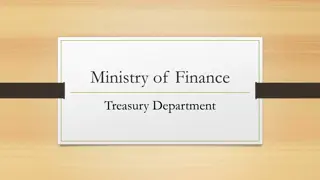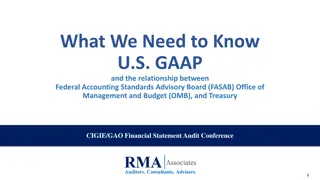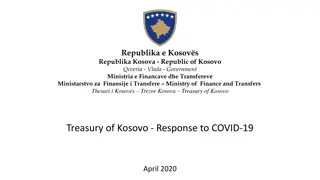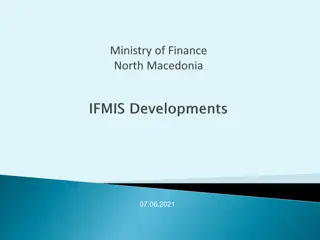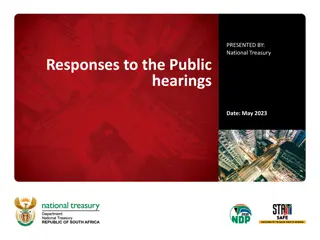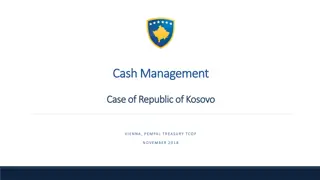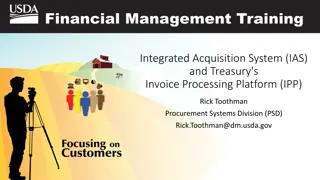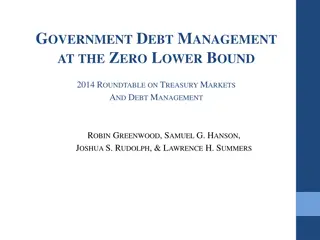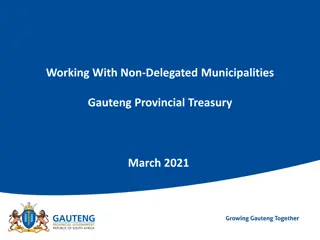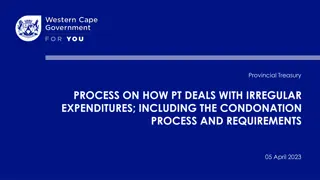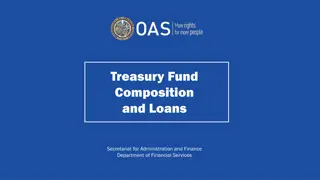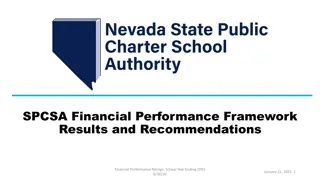Modern Treasury Performance Management Framework
Explore the key elements of measuring and monitoring performance in a modern treasury, highlighting the importance of strategic planning, risk assessment, performance frameworks, and client orientation. Learn about performance evaluation, key performance indicators, and the integration of budget and performance management for efficient resource allocation and program effectiveness.
Download Presentation

Please find below an Image/Link to download the presentation.
The content on the website is provided AS IS for your information and personal use only. It may not be sold, licensed, or shared on other websites without obtaining consent from the author. Download presentation by click this link. If you encounter any issues during the download, it is possible that the publisher has removed the file from their server.
E N D
Presentation Transcript
Measuring and Monitoring Performance in a Modern Treasury Mark Silins TCOP Advisor
Management of Modern Organizations- Requirements Legislative Framework that creates a clear control framework and identifies accountabilities for financial actors Strategic plans that include clear and well considered objectives Operational plans that underpin and are consistent with the Strategic Plan Risk Assessment COSO Job Instructions and Clear understanding of roles and responsibilities A performance management framework and culture Regular Management Reporting Formal Informal Checklists Client Orientation Role of Internal Audit
Integrated Budget and Performance Management Framework Aggregate Fiscal Discipline Resource Allocations Based on Strategic Priorities Efficiency and Effectiveness of Programs and Services Source: Public Expenditure Management Handbook, World Bank, 1998 3
What is Performance Management(1)? the process of quantifying the efficiency and effectiveness of past actions" "the process of evaluating how well organizations are managed and the value they deliver for customers and other stakeholders Good performance is the criterion whereby an organization determines its capability to prevail. While financial information and performance are critically important, the reality in the public service is that social and political elements are also vital for example risk management may be important until a payment is made illegally and the treasury is held responsible Thus an effective performance management system must extend beyond traditional FMIS data to include other performance assessment information (1) Sourced from Wikipedia
Key Performance Indicators Key performance indicators define a set of values against which to measure an organization s performance input activity output outcome Controls Timeliness Process
An Integrated Strategic Performance Framework Development Strategies National Strategic Plans in Ministries Medium Term Budget Framework Programmes (Objectives) Outcomes Activities Outputs Inputs Inputs 6
Types of KPIs Input- how much is spent, the volume of staff hours, material used to build Activity- processing payments, managing cash, producing reports Output number of payments processed, reports produced Outcome- final budget result outcomes depend on strategic objectives Financial- cost of processing a payment Non-financial total number of payments, number of payments processed on due date Efficiency cost to produce each budget report Effectiveness cash forecast within X% of actuals Timeliness payments paid late Control- incidence of payments processed not in compliance with law as % of total payments. Total amount of non-compliant payments Process time and resource taken to review payments centrally
KPIs for Treasury are about internal management and management of budget/spending units KPIs should provide up to date information regarding key areas of risk and workloads for the Treasury. KPIs should also be developed to monitor performance and compliance of spending units KPIs should also be developed regarding other areas of risk including internal controls regarding fraudulent or unusual payments
Government Payment Process- Possible KPIs All government payments are made on the due date in accordance with government legislative requirements Deviation from the due date for payment the goal is not to pay immediately but just-in-time calculate the cost of cash investments foregone Volume and value of payments not made through FMIs Volume and value of payments not paid via bank transfers Impact of large unscheduled payments on cash balances Incidence of detected fraud Cost of ex-ante control function cost per payment- number of detected errors/frauds as a % of total cost Total cost of resources in payment process cost per payment
Revenue Collection All revenues are banked and recorded in the ledger each day Volume and value of revenues collected electronically Value of dishonoured cheques Value of unidentified receipts as % of total Timeliness of revenue reporting - % of revenues not reported the day of collection % of Revenues of general government collected outside of the TSA
Cash Management The objective is to ensure cash is available to execute the budget just-in-time and that government s cash management arrangements are optimized (subject to risk management) Cash forecast is within X% of actuals % deviation from targeted cash balance of TSA value of investment foregone Amount of interest collected for the budget Cost of borrowing (as a total and as an estimate due to forecasting issues)
Bank Reconciliation The objective is to ensure all cashflows are recorded correctly each day in the general ledger Bank ledger discrepancy Date of most recent reconciliation Number of errors Value of errors Oldest/largest error Average time to clear
In-Year and Financial Reporting Reports are produced which are reliable and timely Error corrections required for reporting reliability Reports not produced within X days of end of month/year Material corrections to reports post issuance Incidence of additional queries from executive regarding reports
What happens when KPIs are poorly designed or objectives are not well formulated? 100% of all payments are subject to ex-ante controls rent seeking and total cost of payment process Maximize returns on government cash balances investments which negatively impact market or are high risk Payments made within one day of receipt cash foregone from early release of payment
The Modern role of Transparency in performance management Allowing access to all data allows stakeholders to integrate and review past actions and performance The knowledge that actions are publicly reviewable can enhance controls Publishing procurements above XX value Publishing reports on internet Online access to all FMIS data Georgia Internal and external audit are also important in the overall control framework including in reviewing the appropriateness of KPIs
Conclusions If we do not measure it we can not manage it Performance measurement is key but ultimately we must move up the hierarchy to assess whether the activities of government are contributing to positive outcomes This requires sophisticated systems these systems take time to develop Public servants should be responsible for outputs government is responsible for outcomes 16





